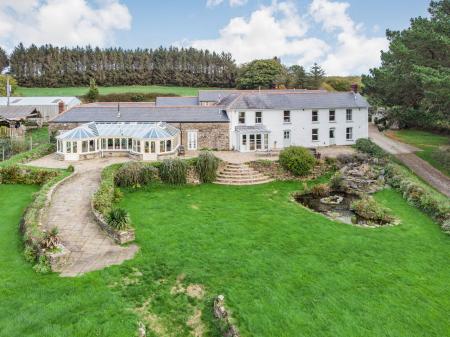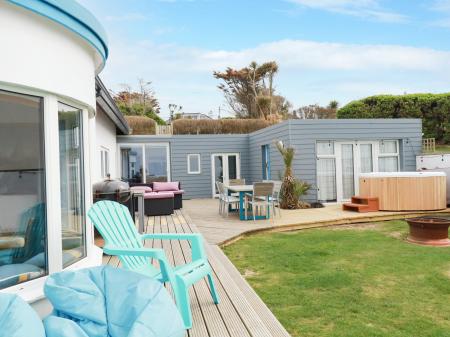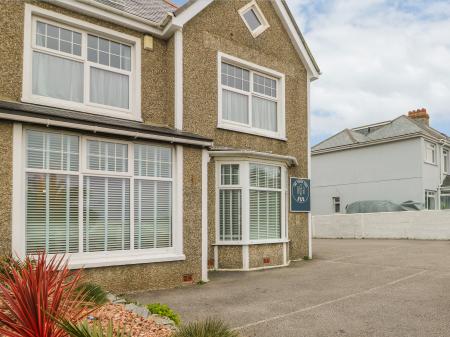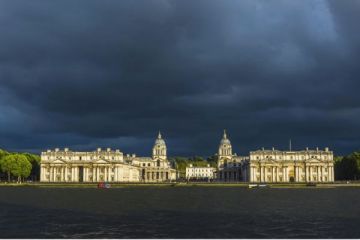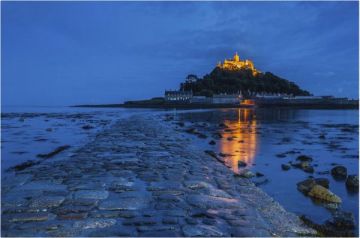Here's a look at London's top 20 historic sites, focusing on their historical significance and associations. I have personally visited each site and all photographs are mine. For each site, I've included detailed information about:
- The site's origins and founding
- Key historical events that took place there
- Architectural features and design significance
- Famous historical figures associated with each location
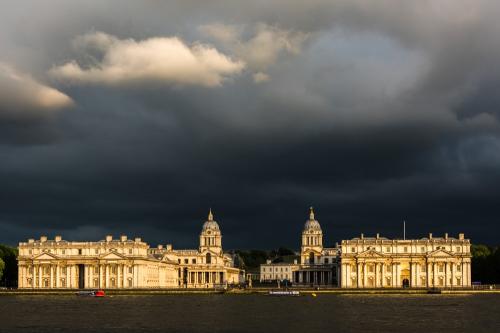
The list covers a wide range of historical periods from Roman times through the Tudor era, the Great Fire of London, Victorian innovations, up to 20th-century wartime history. Each entry provides context about why these sites are significant to London's history and British heritage more broadly.
Of course, the list could be longer and you can argue about which sites deserve to be mentioned and in which order, but I don't think anyone could dispute that these remarkable historic sites should be on any visitor's list!
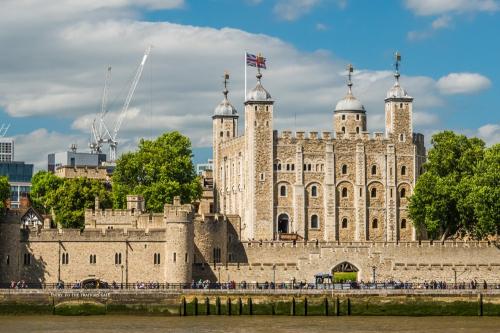
The Tower of London, officially Her Majesty's Royal Palace and Fortress of the Tower of London, was founded in 1066 following the Norman Conquest. William the Conqueror built the White Tower, the central keep, to intimidate the native Londoners and establish Norman control over the capital.
This massive stone fortress has served as a royal residence, armoury, treasury, zoo, and most infamously, as a prison and execution site for figures like Anne Boleyn, Thomas More, and Lady Jane Grey.
Over the centuries, the Tower expanded beyond the White Tower into a complex of multiple buildings surrounded by defensive walls and a moat. Today, it houses the Crown Jewels of the United Kingdom, including the Imperial State Crown and Sovereign's Sceptre with Cross.
The Tower is also home to the ceremonial Yeoman Warders (Beefeaters) and the legendary ravens, whose presence, according to superstition, ensures that the British monarchy and the Tower itself will stand forever.
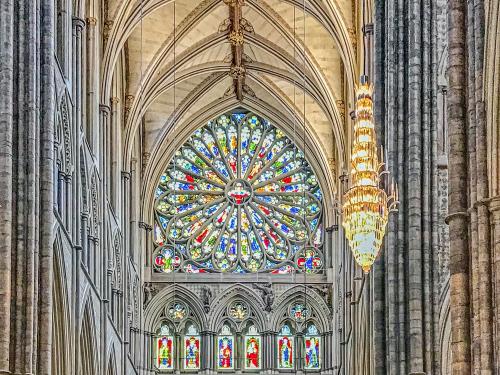
2. Westminster Abbey
Westminster Abbey, officially the Collegiate Church of Saint Peter at Westminster, has been the coronation church for English and British monarchs since 1066. Founded by Edward the Confessor and consecrated on Christmas Day in 1065, the present church was largely rebuilt between 1245 and 1517 in the Gothic style. The Abbey has witnessed not only coronations but also 16 royal weddings, including Prince William and Catherine Middleton in 2011.
The Abbey serves as the final resting place for 17 monarchs, numerous poets, scientists, and statesmen in "Poets' Corner" and other areas. Notable burials include Geoffrey Chaucer, Charles Darwin, Isaac Newton, and Charles Dickens. The magnificent Henry VII Chapel, with its intricate fan vaulting, represents the height of late medieval English architecture.
Westminster Abbey is not just a place of worship but a living pageant of British history, with monuments and memorials spanning nearly a thousand years.

3. Houses of Parliament and Big Ben
The Houses of Parliament, officially the Palace of Westminster, stands on a site that has been the centre of political power in England since the 11th century. The current Gothic Revival building, designed by Charles Barry and AW Pugin, was constructed between 1840 and 1870 after a devastating fire destroyed the previous medieval complex in 1834. The palace serves as the meeting place for both the House of Commons and the House of Lords, the two houses of the Parliament of the United Kingdom.
The most iconic feature of the complex is Elizabeth Tower, commonly known as Big Ben (though this name technically refers to the main bell inside). The tower stands 96 meters tall and houses a four-faced clock that has become one of London's most recognizable symbols.
The palace contains over 1,100 rooms, including the ornate House of Lords chamber with its red benches and the more austere green-benched House of Commons. The building witnessed crucial moments in British history, including the passing of the Reform Acts, debates on World Wars, and the evolution of British democracy.

St Paul's Cathedral, with its magnificent dome dominating London's skyline, was designed by Sir Christopher Wren and built between 1675 and 1710 after the Great Fire of London destroyed the previous medieval cathedral. This masterpiece of English Baroque architecture stands as Wren's greatest achievement and a symbol of London's resilience.
The cathedral's 111-metre dome was inspired by St Peter's Basilica in Rome and was the tallest building in London until the 1960s.
St Paul's has been the site of many significant national events, including the funerals of Lord Nelson, the Duke of Wellington, Winston Churchill, and Margaret Thatcher, as well as the wedding of Prince Charles and Lady Diana Spencer in 1981.
The cathedral miraculously survived the Blitz during World War II, with its dome standing defiantly among the smoke and flames, an image that became an iconic symbol of British determination to survive the attacks.
The Whispering Gallery, located 30 metres above the cathedral floor, is famous for its acoustic properties, allowing whispers to be heard on the opposite side of the dome.

Buckingham Palace, the official London residence of the British sovereign, has served as the principal royal residence since Queen Victoria's accession in 1837. Originally built in 1703 as a private residence for the Duke of Buckingham, it was acquired by King George III in 1761 as a private retreat for Queen Charlotte.
The palace underwent major expansions in the 19th century, including the addition of the famous East Front in the 1850s, which now serves as the public face of the palace.
The palace contains 775 rooms, including 19 state rooms, 52 royal and guest bedrooms, 188 staff bedrooms, and 92 offices. It has witnessed countless historical events, from wartime broadcasts by King George VI to Queen Elizabeth II's record-breaking 70-year reign.
The Changing of the Guard ceremony, where the King's Guard hands over responsibility for protecting the palace to the New Guard, has become one of London's most popular tourist attractions.
During the summer months, the State Rooms are open to the public, offering a glimpse into the lavish interiors where the monarch entertains guests during state visits and official functions.

The British Museum, founded in 1753, was the first national public museum in the world. Its foundation was based on the collection of physician and naturalist Sir Hans Sloane, who bequeathed his collection of over 71,000 items to King George II for the benefit of the nation.
The museum first opened to the public in 1759 at Montagu House in Bloomsbury, the site of the current building. The iconic Greek Revival façade and famous Reading Room were added in the 19th century.
The museum houses approximately eight million works spanning human history, art, and culture, including the Rosetta Stone, which was key to deciphering Egyptian hieroglyphs, the controversial Elgin Marbles from the Parthenon, and the Mausoleum at Halicarnassus.
The British Museum's collection development was deeply intertwined with the expansion of the British Empire, raising ongoing questions about repatriation and cultural heritage. Despite these controversies, the museum remains one of the world's most comprehensive records of human civilization, attracting approximately six million visitors annually.

Hampton Court Palace, located in the borough of Richmond-upon-Thames, was originally built for Cardinal Thomas Wolsey in 1515, but was later seized by King Henry VIII when Wolsey fell from favour. Henry VIII expanded the palace considerably, making it one of his most favoured residences.
The palace represents two distinct architectural styles: the original Tudor red-brick design and the Baroque additions commissioned by William III and Mary II in the late 17th century when they employed Sir Christopher Wren to rebuild parts of the Tudor palace.
Hampton Court is famous for its magnificent gardens, including the Great Vine (planted in 1768 and still producing grapes), the Privy Garden, and the Hampton Court Maze.
The palace is reputedly haunted by several ghosts, most famously Catherine Howard, Henry VIII's fifth wife, who was arrested there and later executed. The palace's Tudor kitchens are the most extensive surviving Renaissance kitchens in Europe, once preparing meals for a court of 600 people.
The astronomical clock in the Clock Court, installed in 1540, is still functioning and displays the time, date, phase of the moon, and position of the sun.

8. Tower Bridge
Tower Bridge, one of London's most iconic landmarks, was built between 1886 and 1894 to ease road traffic while maintaining river access to the Port of London. The bridge was designed by city architect Horace Jones and engineer John Wolfe Barry, featuring a combined bascule and suspension bridge design. The distinctive blue and white colour scheme was added in 1977 for Queen Elizabeth II's Silver Jubilee, replacing the original chocolate brown paint.
The bridge's twin towers, built in the Gothic style to harmonize with the nearby Tower of London, house the bascule mechanism that allows the bridge to open for tall ships. The original mechanism was powered by steam hydraulics, an innovative solution of Victorian engineering.
The high-level walkways, originally designed for pedestrians to cross when the bridge was raised, now house an exhibition about the bridge's history.
Tower Bridge has witnessed numerous historical events, including both World Wars, when it was a strategic target for potential bombing. Today, it remains both a vital London thoroughfare and a symbol of the city, raising its bascules around 1,000 times per year.
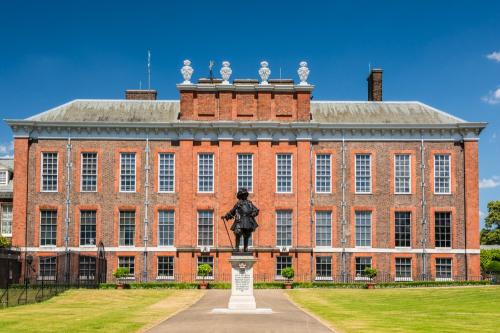
Kensington Palace became a royal residence when it was purchased by King William III and Queen Mary II in 1689. Sir Christopher Wren was commissioned to expand and improve the original mansion, transforming it into a suitable royal residence. The palace has been home to many members of the royal family, including Queen Victoria, who was born there in 1819 and received news of her accession to the throne while residing at Kensington.
In more recent history, Kensington Palace became the home of Diana, Princess of Wales, following her marriage to Prince Charles in 1981, and remained her official residence even after their divorce. After Diana's death in 1997, the palace gates became a focal point for public mourning, with thousands of floral tributes placed there.
Today, parts of the palace are open to the public, while other areas serve as the official London residence for the Prince and Princess of Wales and their children. The palace's Orangery and beautifully landscaped gardens, including the Sunken Garden where Prince Harry and Meghan Markle announced their engagement, are popular visitor attractions.

Shakespeare's Globe Theatre, while not the original structure, is a meticulous reconstruction of the Elizabethan playhouse associated with William Shakespeare. The original Globe was built in 1599 by Shakespeare's playing company, the Lord Chamberlain's Men, and was destroyed by fire in 1613 during a performance of Henry VIII when a theatrical cannon misfired. A second Globe was built on the same site in 1614 but was closed in 1642 by the Puritans, who banned theatrical performances.
The modern reconstruction, completed in 1997, was the brainchild of American actor and director Sam Wanamaker, who spent 23 years campaigning for its creation. Located about 230 meters from the original site, the new Globe is built using authentic materials and techniques from the Elizabethan era, including oak laths and plaster walls, and the first thatched roof permitted in London since the Great Fire of 1666.
The theatre operates as Shakespeare intended, with an open-air performance space and standing-room for "groundlings" in the yard. This working theatre continues Shakespeare's legacy, presenting both traditional and innovative interpretations of his works to modern audiences.
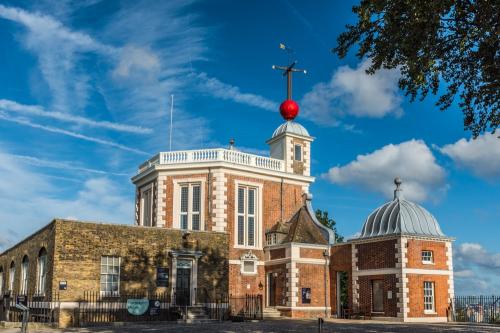
11. Greenwich Royal Observatory
The Royal Observatory in Greenwich was commissioned by King Charles II in 1675 with the specific purpose of "finding the longitude of places" to aid maritime navigation. Sir Christopher Wren designed the original building, and John Flamsteed was appointed as the first Astronomer Royal. The observatory sits on the Prime Meridian of the World (0° longitude), established in 1851 by Sir George Airy, the seventh Astronomer Royal.
The observatory became internationally important in 1884 when, at the International Meridian Conference in Washington, D.C., the Greenwich Meridian was adopted as the prime meridian of the world. This decision established Greenwich Mean Time (GMT) as the global standard for timekeeping.
The famous time ball on the observatory's roof, installed in 1833, was one of the world's first public time signals, dropping at 1 p.m. each day to allow ships on the Thames to set their chronometers.
Today, the observatory is part of the Royal Museums Greenwich, housing important astronomical and navigational instruments, including Harrison's marine chronometers that solved the longitude problem.

12. Ham House
Situated on the banks of the River Thames in Richmond, Ham House stands as one of Europe's most complete and atmospheric 17th-century houses.
Built in 1610 for Sir Thomas Vavasour, Knight Marshal to James I, the house gained its greatest significance when it came into the possession of the formidable Elizabeth Murray, Countess of Dysart, and later her husband, the Duke of Lauderdale. Together, the Lauderdales transformed Ham House into a lavish showcase of wealth and status.
The couple's political ambitions and continental tastes are reflected in the house's impressive interiors, which remain remarkably intact and represent one of the most complete collections of Stuart era furnishings, textiles, and decorative arts in existence.
Visitors to Ham House can explore a treasure trove of historical interiors spanning intimate private rooms, lavish state apartments, and service areas below stairs.
Highlights include the Great Hall with its black and white checkered marble floor, the ornate Great Staircase, and the unique Duchess's Bathroom - an exceptionally rare surviving 17th-century bathing room. The Long Gallery features an impressive collection of portraits and decorative items, while the Cabinet Room displays the Duke's collection of miniatures and curiosities.
The house is complemented by formal gardens that have been restored to their 17th-century splendor, featuring geometric patterns, gravel paths, and ornamental plantings typical of the period. The Cherry Garden offers a particularly impressive example of Stuart garden design with its lavender-edged parterres and replica marble statues.
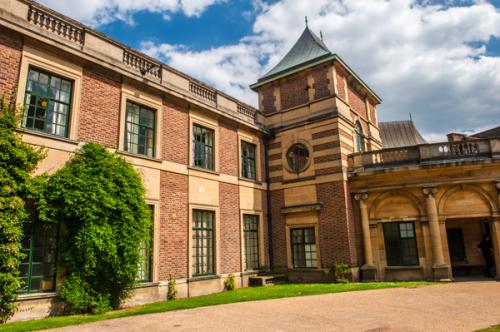
13. Eltham Palace
Eltham Palace, located in southeast London, began as a medieval royal residence in the 14th century. Originally built for Edward II, it reached its zenith under Edward IV who constructed the magnificent Great Hall with its impressive hammer-beam roof.
The palace served as an important royal residence for over 300 years, hosting notable figures including Henry VIII, who spent much of his childhood there. Following the Tudor period, the palace declined in importance as Greenwich and Hampton Court became more favoured royal residences.
After centuries of neglect, Eltham Palace experienced a remarkable renaissance in the 1930s when wealthy socialites Stephen and Virginia Courtauld acquired the lease. They commissioned architects Seely and Paget to create an ultra-modern Art Deco mansion adjoining the medieval Great Hall.
The resulting building is one of Britain's finest examples of Art Deco design, featuring innovative circular rooms, luxurious bathrooms, and sophisticated entertaining spaces that showcase the glamorous lifestyle of the interwar period.
Highlights include the stunning entrance hall with its domed ceiling and marquetry walls, Virginia Courtauld's gold-plated bathroom, and the map room where the couple planned their extensive travels. The basement houses a unique reinforced basement built as a bomb shelter during WWII.
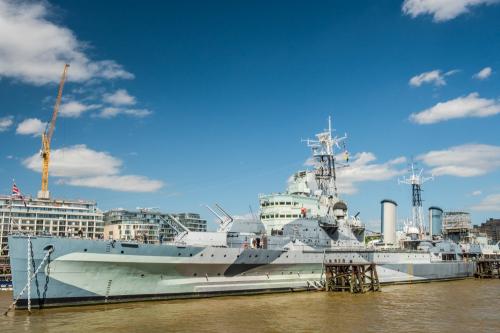
14. HMS Belfast
HMS Belfast, a Town-class light cruiser built for the Royal Navy, now permanently moored on the River Thames, served during World War II and the Korean War. Launched in March 1938, the ship played a significant role in the Battle of North Cape in 1943, where it helped sink the German battlecruiser Scharnhorst. HMS Belfast also participated in the D-Day landings in June 1944, firing some of the first shots on D-Day in support of troops landing on Juno Beach.
After the war, HMS Belfast was recommissioned and saw action during the Korean War from 1950-1952, participating in the Han River operation and the Battle of Inchon.
The ship was decommissioned in 1963 after 24 years of service. In 1971, thanks to a campaign led by a group of former sailors, HMS Belfast was saved from being scrapped and opened as a museum ship.
Today, as part of the Imperial War Museum, visitors can explore all nine decks of this floating museum, experiencing what life was like for the crew of up to 950 men who served on board, from the engine rooms to the captain's bridge.

The Monument, a 62-meter tall Doric column located near the northern end of London Bridge, was designed by Sir Christopher Wren and his colleague Dr Robert Hooke to commemorate the Great Fire of London of 1666. Construction began in 1671 and was completed in 1677.
The Monument stands precisely 202 feet (61.5 meters) from the spot in Pudding Lane where the fire is believed to have started at the bakery of Thomas Farriner. The Monument's height matches its distance from the fire's starting point, a deliberate design choice by Wren.
The column is topped by a flaming urn of gilt bronze, symbolizing the fire. Inside the column is a spiral staircase of 311 steps leading to a viewing platform.
The base of the Monument features allegorical sculptures and inscriptions in Latin that describe the devastation of the fire and the city's subsequent resurrection under Charles II. The Great Fire destroyed 13,200 houses, 87 parish churches, St. Paul's Cathedral, and most of the buildings of the City authorities, but caused surprisingly few verified deaths. The Monument stands as a testament to London's resilience and ability to rebuild after disaster.

16. Whitehall Palace (Banqueting House)
The Banqueting House is the only surviving complete building of Whitehall Palace, once the largest palace in Europe and the main residence of English monarchs from 1530 to 1698.
Designed by Inigo Jones and completed in 1622, the Banqueting House represents the first truly Renaissance building in England, breaking away from the Tudor style that had dominated English architecture. The building's most spectacular feature is its ceiling, painted by Peter Paul Rubens in 1636, depicting the Apotheosis of James I.
The Banqueting House witnessed one of the most dramatic moments in English history when, on January 30, 1649, King Charles I was beheaded on a scaffold erected outside its windows. Charles reportedly wore two shirts that day, concerned that if he shivered from the cold, his enemies might mistake it for fear.
The palace complex was largely destroyed by fire in 1698, with only the Banqueting House surviving. Today, the building serves as a museum and a reminder of the lost grandeur of Whitehall Palace, which once contained approximately 1,500 rooms and stretched along the Thames from Whitehall to Westminster.

17. The Old Royal Naval College, Greenwich
The Old Royal Naval College in Greenwich stands on the site of the Palace of Placentia, the birthplace of Henry VIII and Elizabeth I. After the palace fell into disrepair, it was demolished, and Charles II planned to build a new palace on the site. However, the project was abandoned, and Mary II later decreed that the site should be used for a Royal Hospital for Seamen.
The spectacular baroque buildings that now stand were designed by Sir Christopher Wren and Nicholas Hawksmoor, built between 1696 and 1712.
The complex served as a naval hospital until 1869, when it became the Royal Naval College, training officers for the Royal Navy until 1998. The site includes the stunning Painted Hall, often called "Britain's Sistine Chapel," featuring Sir James Thornhill's masterpiece of baroque painting that took 19 years to complete. The Chapel of St. Peter and St. Paul, with its intricate plasterwork, is another architectural highlight.
Now part of the Maritime Greenwich World Heritage Site, the buildings house the University of Greenwich and Trinity Laban Conservatoire of Music and Dance, while remaining open to visitors as one of London's most spectacular architectural ensembles.

18. The Jewel Tower
The Jewel Tower, built in 1365, is one of the few surviving sections of the medieval Palace of Westminster. Commissioned by King Edward III, it was constructed to house the royal treasures (hence its name) and to provide secure storage for the king's personal belongings. The three-story tower was surrounded by a moat for added security and was accessed via a drawbridge.
After the royal family moved their main residence from the Palace of Westminster in 1512, the Jewel Tower's purpose changed. From 1621, it was used to store parliamentary records, and from 1869 to 1938, it served as the Standards Office, where the official weights and measures of the United Kingdom were held and verified.
The tower survived both the great fire of 1834, which destroyed much of the medieval palace, and the Blitz during World War II. Today, managed by English Heritage, the Jewel Tower offers visitors a glimpse into medieval craftsmanship with its ribbed vaulting and decorative ceiling bosses, as well as an exhibition on the history of Parliament.
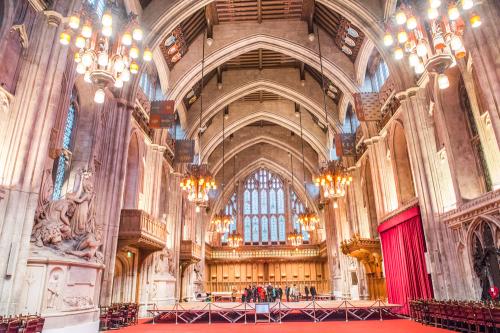
19. London Guildhall
London's Guildhall, situated in the City of London, has been the administrative centre of the City since the Middle Ages. The current building, largely dating from 1411-1440, was designed in the perpendicular Gothic style and miraculously survived both the Great Fire of London in 1666 and the Blitz during World War II, though it was significantly damaged in both events.
The building's imposing façade, with its distinctive porch added in the early 20th century, has witnessed centuries of civic ceremonies and historical events.
The Great Hall, measuring 151 feet long and 48 feet wide, is the largest civic hall in England and has hosted numerous state and civic events, including the trials of Lady Jane Grey and Thomas Cranmer.
The hall features magnificent stained-glass windows depicting historic scenes and is flanked by statues of the mythical giants Gog and Magog, traditional guardians of the City of London. Beneath the Guildhall lies London's largest medieval crypt, surviving from the original 1411 building.
Today, the Guildhall continues to serve its civic function while also housing the Guildhall Art Gallery and the remains of London's Roman amphitheatre, discovered during redevelopment work in 1988.
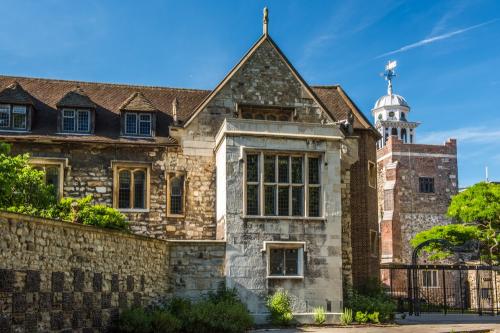
20. The Charterhouse
The London Charterhouse, located in Smithfield, began as a Carthusian monastery in 1371, founded during the Black Death. After the dissolution of the monasteries under Henry VIII in 1537, when several monks were executed for refusing to accept the king as head of the Church, the site became a grand Tudor mansion.
Notable residents included Elizabeth I, who stayed here before her coronation, and James I, who held court here during the early days of his reign.
In 1611, the wealthy Thomas Sutton purchased the Charterhouse and established a charitable foundation consisting of an almshouse and a school. Charterhouse School relocated to Surrey in 1872, but the almshouse continues to function today, providing accommodation for elderly men known as "Brothers."
The complex includes a Tudor great hall, a chapel with alabaster monuments, and a Great Chamber with an ornate ceiling dating from the 16th century. The Charterhouse survived the Great Fire and was damaged but not destroyed during World War II.
Today, parts of the complex are open to the public, offering a rare glimpse into London's medieval and Tudor past in the heart of the modern city.
Honourable Mention
Of course, the 20 sites listed here are really just the icing on the cake; London is blessed with a wealth of other historical attractions that are well worth a visit.
My own personal 'Best of the Rest' list would include the Churchill War Rooms, Apsley House, Forty Hall, Ham House, Marble Hil House, Strawberry Hill House, and Syon Park, to name just a few. I'm sure any London native could easily add another 20 (or 30 or 40) to the list.
MOST POPULAR POSTS
